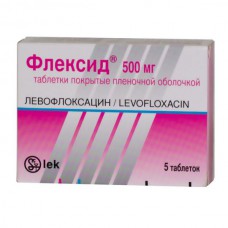Expiration date: 02/2026
The composition and form of issue:
Tablets, film-coated. 1 tablet contains active substance:
levofloxacin (hemihydrate) 250 or 500 mg
excipients: lactose monohydrate, povidone, carboximetilkrahmal sodium, talc, silica colloidal anhydrous, croscarmellose sodium, glyceryl dibehenate
shell: hypromellose, hyprolose, macrogol 6000, iron oxide yellow, iron oxide red, titanium dioxide, talc
blistere in 5, 7 or 10 tablets, in cardboard pack 1, 2, 3 or 5 blisters.
Description pharmaceutical form:
Bright orange-pink, octagonal, biconvex tablets scored on both sides (dosage of 250 mg) or on one side (dose 500 mg).
Pharmacokinetics:
Suction
When administered levofloxacin is rapidly and almost completely absorbed from the gastrointestinal tract, drug bioavailability is approximately 100%. Cmax in plasma achieved within 1 h. food Intake has practically no effect on absorption of levofloxacin.
Distribution
The plasma protein binding is 30-40%. Accumulation of levofloxacin when taken in the dose of 500 mg 1 time per day is almost not observed. Minor accumulation of levofloxacin observed when taken in the dose of 500 mg twice a day. Constant concentration is achieved within 3 days.
After oral taking 500 mg of levofloxacin: Cmax in bronchial mucosa and bronchial secret is achieved approximately 1 h after administration of the drug and are 8, 3 and 10, 8 µg/ml respectively in lung tissue after 4 to 6 h after administration of the drug and is approximately 11, 3 µg/ml. Concentration in the lungs exceeds the concentration in plasma. Levofloxacin poorly penetrates into the cerebrospinal fluid.
The average concentrations of the drug in the urine 8-12 hours after administration of single oral doses of 150, 300 or 500 mg is 44, 91 and 200 mg/l, respectively.
Metabolism
Levofloxacin is metabolized to a very small extent with the formation of desmethyl-levofloxacin and levofloxacin-N-oxide. These metabolites account for less than 5% of the dose secreted through the kidneys.
Excretion
As a result of intake of levofloxacin is eliminated from plasma relatively slowly (T1/2 is 6-8 hours). Excretion of the drug mainly by the kidneys (more than 85% of the administered dose).
Patients with renal insufficiency
The impairment of renal function affects the pharmacokinetics of levofloxacin. The excretion via the kidneys declines with the decline of renal function and, respectively, T1/2 increases, as shown in the table below:
| Creatinine Cl, ml/min | <20 | 20–40 | 50–80 |
| T1/2, h | 35 | 27 | 9 |
Elderly patients
Kinetics of levofloxacin in elderly age has no significant differences, except those associated with changes in creatinine clearance.
Description pharmacological action:
Levofloxacin is a bactericidal antimicrobial drug with broad spectrum of action, does DNK-girazu and topoisomerase IV, inhibits DNA synthesis.
Levofloxacin is active against:
aerobic gram-positive microorganisms — Enterococcus faecalis , Staphylococcus aureus sensitive to methicillin, Staphylococcus haemolyticus, methicillin-sensitive, Staphylococcus saprophyticus, Streptococcus groups C and G, Streptococcus agalactiae, Streptococcus pneumoniae, Streptococcus pyogenes
aerobic gram — negative microorganisms Acinetobacter baumannii, Citrobacter freundii, Eikenella corrodens, Enterobacter aerogenes, Enterobacter agglomerans, Enterobacter cloacae, Escherichia coli, Haemophilus influenzae, Haemophilus parainfluenzae, Klebsiella oxytoca, Klebsiella pneumoniae, Moraxella catarrhalis, Morganella morganii, Pasteurella multocida, Proteus mirabilis, Proteus vulgaris, Providencia rettgeri, Providencia stuartii, Pseudomonas aeruginosa, Serratia marcescens
other microorganisms Chlamydia pneumoniae, Chlamydia psittaci, Legionella pneumophila, Mycoplasma pneumoniae.
Organisms with intermediate sensitivity:
aerobic gram — positive microorganisms Staphylococcus haemolyticus resistant to methicillin
aerobic gram-negative bacteria — Burkholderia cepacia
anaerobic microorganisms Bacteroides ovatus, Bacteroides thetaiotamicron, Bacteroides vulgatus, Clostridium difficile.
To levofloxacin insensitive:
Staphylococcus aureus resistant to methicillin.
Indications:
Infections caused by susceptible strains of microorganisms:
- infections of ENT-organs (acute sinusitis)
- infections of the lower respiratory tract (acute bronchitis, chronic bronchitis, community acquired pneumonia)
- uncomplicated infections of the urinary tract and kidneys
- complicated infections of the urinary tract and kidneys (including pyelonephritis)
- prostatitis
- infections of skin and soft tissues.
Contraindications:
- hypersensitivity to levofloxacin or other hinolonam, and/or other components of the drug
- epilepsy
- lesions of the tendons, occurred during previous treatment with fluoroquinolones
- childhood and adolescence (up to 18 years)
- pregnancy and lactation.
Caution: the appointment of levofloxacin in combination with drugs affecting tubular secretion such as probenecid and cimetidine, especially in patients with impaired renal function. In the treatment of patients with a predisposition to epileptic seizures, during treatment fenbufen and similar NSAIDs or drugs that lower the threshold for epileptic seizures, such as theophylline. Patients with latent or apparent violations of the activity of glucose-6-fosfatdegidrogenaza (the risk of development of hemolytic reactions).
Side effects:
Frequency of occurrence is characterized as: very common (>10%) common (1-10%) uncommon (0, 1-1%) rare (0, 01-0, 1%) and very rare (<0, 01%).
Allergic reactions: rare — itching, rash rare — urticaria, bronchospasm, dyspnoea very rare — angioedema, hypotension, anaphylactic shock, allergic pneumonitis, photosensitivity isolated cases — Stevens-Johnson syndrome, toxic epidermal necrolysis (Lyell's syndrome), erythema multiforme.
From the digestive system, metabolism: common — nausea, diarrhea (including with blood), increased liver enzymes (ALT, AST) uncommon — loss of appetite, vomiting, abdominal pain, dyspepsia, hyperbilirubinemia rare — enterocolitis, pseudomembranous colitis, very rare — hypoglycemia, hepatitis.
From the nervous system: rare — headache, dizziness, sleep disturbance rare — paresthesia, tremor, anxiety, agitation, confusion, seizures, very rare — hallucinations, extrapyramidal disorders and other disorder.
From the sensory organs: very rare — disorders of vision, hearing, olfactory, gustatory and tactile sensitivity.
From the CCC: rare — tachycardia, hypotension very rare vascular collapse.
From the side of musculoskeletal system: rare — artralgia, myalgia, tendonitis is very rare — tendon rupture (e.g. Achilles tendon) muscular weakness (is of particular importance for patients with myasthenia gravis) individual cases — rhabdomyolysis.
From the urinary system: rare — gipercreatininemia very rare — interstitial nephritis, kidney function impairment up to acute renal failure.
From the blood and organs of hematopoiesis: uncommon — eosinophilia, leucopenia rare — neutropenia, thrombocytopenia very rare agranulocytosis isolated cases — haemolytic anaemia, pancytopenia.
Other: uncommon — asthenia very rare — fever, vasculitis.
Drug interactions:
Iron salts, antacids containing magnesium or aluminum decrease the absorption of levofloxacin.
Sucralfate reduces the bioavailability of levofloxacin.
Revealed no pharmacokinetic interaction between levofloxacin and theophylline. However, if concomitant use of quinolones, theophylline, and NSAIDs may decrease the seizure threshold.
In the presence of fenbufen concentration of levofloxacin is approximately 13% higher than when used as monotherapy.
With concomitant use of levofloxacin T1/2 of cyclosporine is increased by 33%.
While receiving levofloxacin and vitamin K antagonists (e.g. warfarin), an increase of the parameters of coagulation (PV) and/or bleeding.
Method of application and dose:
Inside, one or two times a day, regardless of meals, with liquid squeezed enough liquid.
The dose and duration of treatment depends on the indications and severity of disease. Selection of dose the tablet can be divided into parts at dividing risk. Treatment with Flexid should continue for at least another 48-72 hours after disappearance of symptoms.
The maximum duration of treatment — no more than 14 days.
In the application of levofloxacin the recommended doses are:
Doses for patients with normal renal function (creatinine Cl >50 ml/min)
| Indication | Daily dose (depending on severity) | The duration of treatment, days |
| Acute sinusitis | 500 mg 1 time per day | 10–14 |
| Exacerbation of chronic bronchitis | 250–500 mg 1 time per day | 7–10 |
| Community-acquired pneumonia | 500 mg 1 or 2 times per day | 7–14 |
| Uncomplicated urinary tract infection | 250 mg 1 time per day | 3 |
| Complicated urinary tract infections (including pyelonephritis) | 250 mg 1 time per day | 7–10 |
| Prostatitis | 500 mg 1 time per day | 14–28 |
| Infections of skin and soft tissue | 250 mg 1 time per day or 500 mg 1 or 2 times per day | 7–14 |
Patients with impaired renal function a selection of individual doses.
Doses for patients with impaired renal function (Cl creatinine &le50 ml/min)
| Creatinine Cl, ml/min | Doses depending on nosology and severity of the condition | ||
| first dose — 250 mg/24 h | first dose — 500 mg/24 h | first dose — 500 mg/12 h | |
| 50–20 | then 125 mg/24 h | then 250 mg/24 h | then 250 mg/12 h |
| 19–10 | then 125 mg/48 h | then 125 mg/24 h | then 125 mg/12 h |
| <10 (including hemodialysis and NAPD)* | then 125 mg/48 h | then 125 mg/24 h | then 125 mg/24 h |
*After hemodialysis or continuous ambulatory peritoneal dialysis (NAPD) receive an additional dose is not required.
Doses for patients with impaired liver function
When the liver does not require special selection of doses, as levofloxacin is not subjected to significant metabolism in the liver.
Individual selection of doses for elderly patients is not required (however, it is necessary to monitor creatinine clearance, because greater the likelihood of concomitant loss of kidney function).
Overdose:
The symptoms of nausea, erosion of the mucous membranes of the digestive tract, confusion, dizziness, loss of consciousness and convulsions.
Treatment: symptomatic monitoring parameters ECG hemodialysis is ineffective there is no specific antidote.
Special instructions:
Pills Flexed must be taken 2 hours before or 2 hours after taking iron salts, antacids and sucralfate, since it may be a decrease in its absorption. If necessary, the simultaneous use of sucralfate should be taken 2 hours after taking the pills Flexed.
Patients simultaneously receiving vitamin K antagonists, it is necessary to control the parameters of blood clotting.
In rare cases, observed during treatment hinolonami, tendonitis can sometimes lead to torn ligaments, particularly Achilles tendon. This side effect is seen within 48 h after the start of therapy. For the elderly and patients taking corticosteroids, there is an increased risk of tendinitis. Therefore, during treatment with levofloxacin requires careful monitoring of the condition of such patients. If you suspect tendonitis (it is necessary to inform the patient about his symptoms), the pills are Flexed should stop immediately and start appropriate treatment (e.g. immobilisation). Diarrhea (especially severe, persistent and/or mixed with blood) during or after taking the pills Flexid can be a symptom of diseases caused by Clostridium difficile, the most severe form of which is pseudomembranous colitis. If there is a suspicion of pseudomembranous colitis, pills Flexid should be discontinued immediately and conduct symptomatic treatment (e.g. oral vancomycin). In this condition, drugs that inhibit peristalsis, are contraindicated. For the treatment of hospital infections caused by P. aeruginosa, combination therapy is required.
During treatment, the drug Flexid you should avoid direct sunlight and artificial UV radiation (Solarium), in order to avoid photosensitivity.
Influence on ability to concentrate. Be careful when driving and occupation of other potentially hazardous activities, require high concentration and psychomotor speed reactions.



